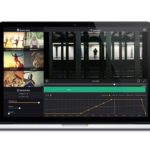
Doing The Heavy Lifting
Posted on Dec 22, 2016 by Julian Mitchell
Drones, UAVs, UASs – they all do the same thing, shoot video from the air. But in the world of cinematic drones and gimbals that’s where the similarities end. We asked Jeremy Braben, CEO of Helicopter Film Services, to explain the world of ‘heavy-lift cinema’
We define them as ‘heavy-lift’ cinema to try and make a distinction, not that anybody uses them less professionally than we do, it’s just that the ones that we operate predominantly are designed for cinema camera payloads,” begins Jeremy Braben, CEO of Helicopter Film Services (HFS). “We’ve just done a test for Marvel and we tested three different aircraft: a homebuilt one, which is a conventional helicopter that can do aerobatics; a DJI Inspire; and our Aerigon. Just in the transcoding of the images before sending them off to the producers, it was staggeringly different between the ALEXA Mini on the Aerigon and the Inspire, even though the Inspire is a 4K drone.”
Current UK aviation laws restrict Helicopter Film Services to a 25kg load for UAV use, that’s the whole package. However this is changing to 20kg, to bring it in line with the rest of Europe. “The CAA wanted photographic evidence that our Aerigon UAV weighed less than 20kg so we had to weigh every component and we got the package down to 19.5kg.”
HFS is also one of only two companies given ten-metre distance exemptions to the public, the norm is 50m. “With the big gimbals and the big aircraft needed to carry the cameras and the lenses that people are demanding in our world these are the laws we have to adhere to, not just the laws of physics,” says Jeremy.
“Both Intuitive Aerial, who make the Aerigon, and Shotover, who make the U1, have to work with the parameters that all of us have to abide by. We also demand a certain quality and working in the areas that we work in, the authorities are looking at us more closely because we are asking them to let us do more.
“In real terms buying a Shotover doesn’t give me anything that, say, an Aerigon doesn’t. It’s another aircraft for our fleet that does what we need, as in carry the higher payloads, the bigger cameras and the longer lenses. The gimbal is $50,000 and the aircraft is about $30,000. We have to have it, I wanted to have the option. Ideally if I could afford it I would have every single product on the shelf so that when a customer calls and wants X, they can have X. Customers do come in and say ‘I only want to use the Shotover’. They may not have ever used it before but the industry gossip, the buzz means it might have become a Hoover in terms of the name.”
 Not every day you see an ARRI 235 35mm film camera on a drone.
Not every day you see an ARRI 235 35mm film camera on a drone.
In combination
The list of camera and lens combinations that companies like HFS use for filming with UAVs is not that restrictive. It’s not an exhaustive list either. It comes down to pretty much two things: weight and size. If it is within the weight and size you can pretty much put anything on there. “We’re constantly adding stuff to Shotover’s list. We’ll always get something thrown at us,” says Jeremy. “For example, a particular DOP wants to use what is considered a strange combination of a vintage lens and something else. We’ve even gone back to putting an ARRI 235 35mm film camera on it. We’re the only people who have ever done it on a UAV. Obviously we couldn’t use a full size ARRI ALEXA and a 10:1 zoom, that’s common sense, it’s limited by payload.
“If we have a new combination we will ask Shotover or whoever for their plans to include them, but we’re a slightly different case as we have in-house abilities. We can manufacture certain parts, we’ve got a rapid prototype and by virtue of the helicopter engineering company we have machining capabilities in-house.”
One use for a UAV that we’ve certainly never heard of before is as a light source. “We’re operating one of our Aerigons at the moment as a light source,” explains Jeremy, “so we have very high output LED light panels from Digital Sputnik on it. We’ve got the camera with a separate drone and the source of light. One is basically a flying gaffer rig and the other is a flying camera. We’ve tested them and it’s extraordinary.”
 Jeremy Braben (left) and Pete Ayriss of HFS on the set of ‘Spectre’.
Jeremy Braben (left) and Pete Ayriss of HFS on the set of ‘Spectre’.
Working Ethic
According to Jeremy there’s a whole working ethic that has to change on set and it goes further than the crew. It has to go to the mindset of, particularly, the ADs who have to be mindful of the restrictions. It’s not that they’re being difficult or awkward it’s just that they have to understand there are limitations. “Obviously we can only carry batteries of a certain weight and that’s where this time restriction has come in,” says Jeremy. “Battery technology is accelerating very quickly, led by the military, of course. The lithium polymer batteries, although they are OK, are fairly unstable. They’re not well liked by anyone who has to transport them and there is the quest for a more stable, high power, low weight battery source. It’s coming, the military have it now. We’re constantly talking about how can we get a hydrogen fuel cell on the top of one of these things and provide the power – that’s the holy grail – getting one of these things flying for considerably longer.”
UAV Redundancy
The big difference between the Aerigon and the Shotover U1 is the number of arms, and therefore motors. The Aerigon has 12: six arms, 12 motors. The Shotover has four arms and eight motors. But if you want to work for some of the big Hollywood studios you need clear redundancy. “One of the advantages we’re getting from the Aerigon is the capability of losing a number of motors and arms in different combinations and still recovering the aircraft safely. There are obviously combinations that you just couldn’t recover from, but the odds are greatly increased with the Aerigon. We’ve shut down two motors on different arms, one whole arm, so it’s coming down on five and that is what has given Disney and Warner Brothers the confidence to grant us the rights to work for them. They won’t entertain any UAV unless it can demonstrate the ability to come back with fewer motors than it went out with. The Shotover has dual redundant flight controllers and the way they’ve done it is very clever. If one fails, the other one automatically takes over and you can bring the aircraft home.”
Shotover also has it and Aerigon is working on it – both manufacturers are working on ballistic recovery with parachutes but every time you add something onto these aircraft, the payload suffers.
Crash landing
There have been a lot of publicised crashes, mostly involving smaller type drones, but there have been a couple of the big ones.
“In broadcast particularly pilots will keep the shot to the last possible moment and the director might want you to stay there longer when you’re screaming ‘I have to land!’ When there is a power issue, generally one side of the aircraft will go before the other and it will pitch over and plummet.
“We’ve had standing rows with production because the pilot’s gone ‘That’s my warning’. We set a warning and keep a little reserve as commercial aircraft do. The pilot and the operator know there is a little bit extra that we’re not telling anybody about, but that’s the safety reserve. We’ve had the alarm go off and the crew have all shouted ‘Drone coming back’, while the AD and director are saying ‘Why are you landing, stay, stay!’
“This is where education comes in, some productions are brilliant and totally understand. All they want to know is when we’re ready to go back in the air. The pilot of the drone needs to be treated like a pilot of an aircraft.”
HFS only operates three-person crews – a camera assistant, a pilot and a camera operator – and they tend to keep the teams together because they each develop their own shorthand. “We have two core teams and we’re building up a third. The assistant is actually more valuable than is apparent on the surface, because they are not only responsible for the camera and the balancing and just working with the camera, changing the media, changing the batteries etc, but they are also very familiar with the operation of these aircraft,” explains Jeremy. “They are a third pair of eyes and often the person who is shouting at other people to make sure the area is clear or something like that. The operator is looking at the monitor, the pilot doesn’t take his eyes off the aircraft. So the assistant is a crucial part of the team and needs to have the personal confidence to shout at an AD or AP, who is not doing their job. That’s crucial in avoiding accidents.”
A lot of people have said that the emergence of drones has affected their helicopter business, but Jeremy counters that assumption, saying “We have not seen a decrease in our helicopter work, we’ve seen an increase in our work and we put that increase down to the drones. I think helicopters have suffered a slight downturn because they are expensive and the first thing that gets cut on a commercial or something is the aerials. But I haven’t seen our helicopter use suffer much, if at all.”
Helicopter Film Services is getting Amazon production money and an awful lot out of Netflix, both drone and helicopter wise, but Netflix are very camera specific, says Jeremy. “They won’t allow the ARRI so you have to REDs or Sonys. We’re doing a lot with some of Amazon’s new programmes and we’ve been using the ALEXA Minis and Amira’s 4K – all the ground cameras are Amiras and aerial cameras are Minis and I really wish that Netflix would do the same.”








